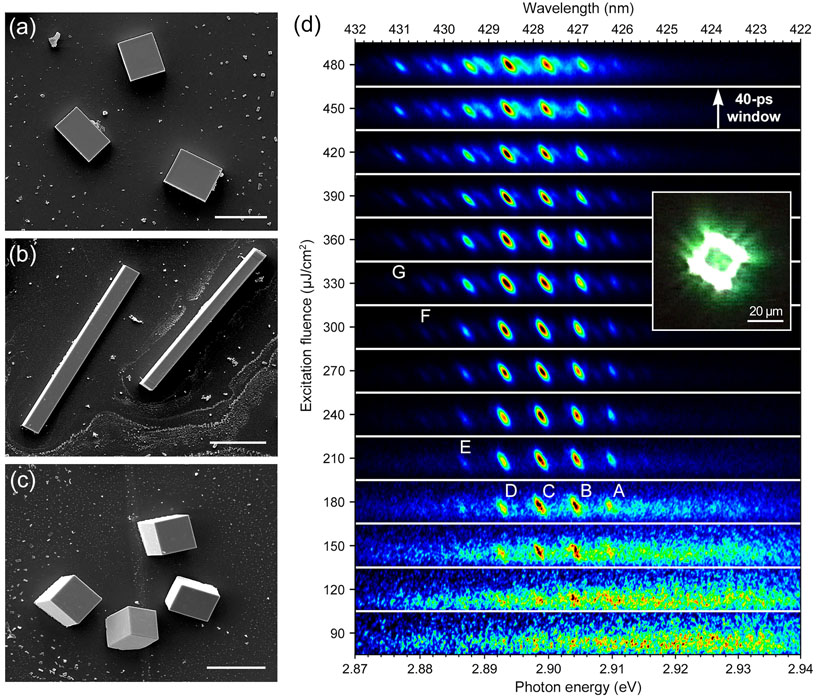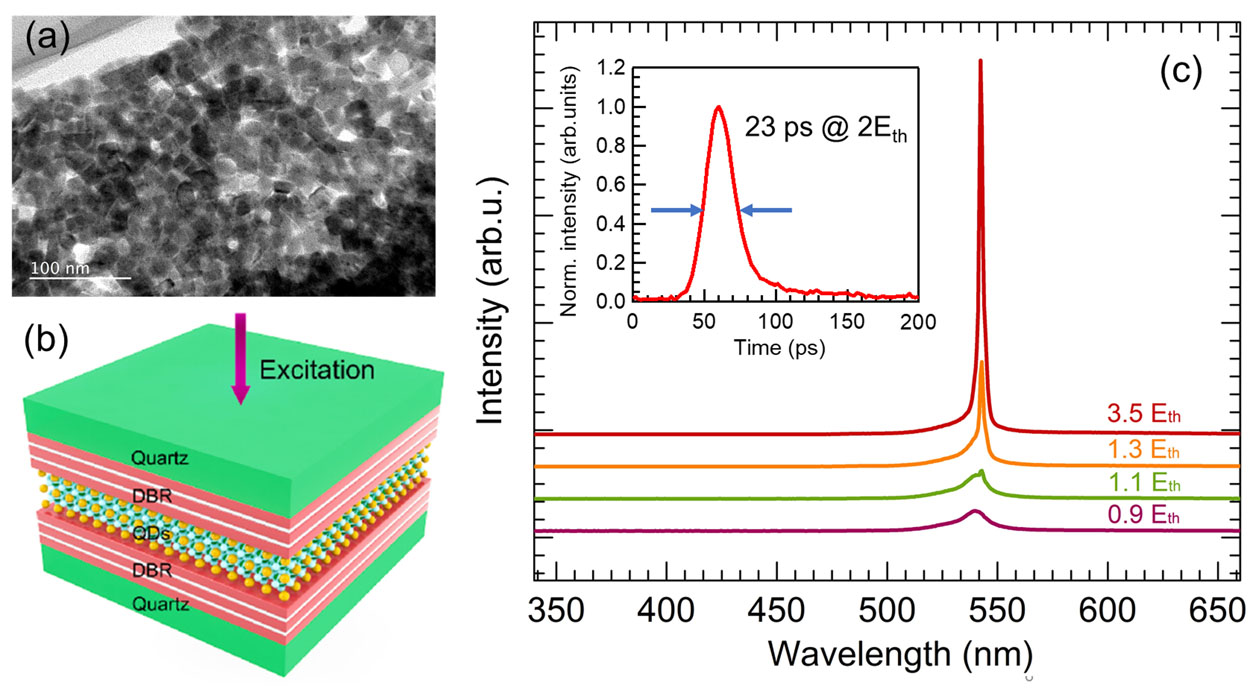Lasing Dynamics in Perovskite Microcavities
S. Chen and H. Akiyama
Perovskite materials have shown remarkable progress in both the field of solar cell and light emitting devices, for solar cell, conversion efficiencies more than 25% have been achieved, and for light emitting devices, perovskite-based vertical cavity surface emitting lasers (VCSEL) and distributed feedback (DFB) lasers have been fabricated, and very fascinating single-mode lasing properties have been demonstrated, however, the detailed lasing mechanism is still unclear.
We have fabricated various kinds of CePbBr3 perovskite microcavities with a low-temperature liquid-phase growth method, such as microplate, microrods, and microcubes, as shown in Figure 1, with a size from several tens to 200 micrometers. A clear substrate dependence of the morphologies of the perovskite microstructures in this growth method has been observed [1]. With the excitation of a femtosecond laser beam from a Ti: sapphire ultrafast laser system, all the microcavities show lasing behavior under elevated excitation densities, the higher carrier density more that Mott density at lasing threshold indicates the lasing behavior in these perovskite microcavities should be mainly related to electron-hole plasma rather exciton.

Fig. 1. SEM micrograph of CsPbBr3 single-crystal microcavities on substrates of (a) single-crystal Si, (b) sapphire, and (c) amorphous quartz. Streak-camera images (d) of the emissions from microplate with various excitation densities. In the vertical dimension, a time range of 40 ps for each slice is shown. The distinct lasing modes are labeled as Mode A (with the highest photon energy) to Mode G (with the lowest photon energy) above the threshold. In each slice, a redshift to low energy with time for each mode is clearly demonstrated. Inset is a lasing image of a microplate under the excitation of femtosecond lasing beam, showing a whispering-gallery mode (WGM) lasing.
The lasing dynamics of the microcavities were further studied with time-resolved photoluminescence system. Figure 2 shows the spectrally and temporally resolved lasing images recorded by a streak camera. With increasing excitation fluences, two importance features have been observed, one is the redshift of the dominant lasing spectra to the low energy side due to the band gap renormalization (BGR) effect, another one is the blueshift of each lasing mode to higher energy side due to the reduction of the refractive index caused by the high injection carrier density. At a certain excitation density, for example 180 μJ/cm2, we can see a redshift of each mode to low energy side with time going on after excitation, which indicates a recovery of index in microcavity, and the blueshift of the total lasing spectra with time going on indicates a recovery of BGR, therefore the lasing dynamics is merged with the transient BGR effect and the transient change of refractive index in perovskite microcavities, detailed explanations can be found in the published paper [2].

Fig. 2. (a) TEM image of CsPbBr3 perovskite nanocrystals with an average size around 12 nm, (b) Schematic of the CsPbBr3 nanocrystal based VCSEL, where the CsPbBr3 nanocrystals are sandwiched with two high-reflectivity DBRs. (c) Emission spectra of the VCSEL with different excitation densities. The inset shows a waveform of the output pulse with a pulse width of 23 ps from the VCSEL with an excitation density 2 times of the threshold.
We also fabricated CsPbBr3 perovskite nanocrystals with a ligand-assisted recrystallization method, and sandwiched the perovskite nanocrystals with two high-reflectivity distributed Bragg reflectors (DBRs) to form a VCSEL device [3]. The lasing performances of the perovskite nanocrystal based VCSEL have been characterized with femtosecond pulse excitations, and single-mode lasing of the VCSEL has been observed. The threshold excitation density was around 8 μJ/cm2. The cavity quality factor Q of the VCSEL is estimated to be around 1425. With the excitation power over 2 times of the threshold, the output pulse width of the perovskite based VCSEL is measured to be around 23 ps, demonstrating a potential application in short pulse generation of perovskite based VCSELs. Investigations on the carrier dynamics in the VCSEL is still in progress.
References
- [1]. G. Weng, J. Yan, S. Chen, C. Zhao, H. Zhang, J. Tian, Y. liu, X. Hu, J. Tao, S. Chen, Z. Zhu, H. Akiyama, and J. Chu, Photonics Res. 9, 54 (2021).
- [2]. G. Weng, J. Tian, S. Chen, J. Yan, H. Zhang, Y. Liu, C. Zhao, X. Hu, X.Luo, J.Tao, S. Chen, Z. Zhu, and J. Chu, H. Akiyama, ACS Photonics 8, 787 (2021).
- [3] C. Zhao, J. Tao, J. Tian, Y. Bai, G. Weng, H. Liu, Y. Liu, J. Yan, S. Chen, Y. Pan, X. Hu, S. Q. Chen, H. Akiyama, L.Wang, and J. Chu, Chemical Engineering Journal, 2020, in press, https://doi.org/10.1016/j.cej.2020.127660
